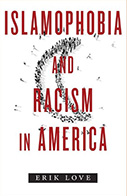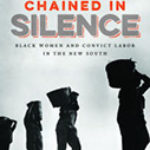ISLAMOPHOBIA AND RACISM IN AMERICA

Author: Erik Love
Publisher: New York: New York University Press, 2017. 272 p.
Reviewer: Sabri Ciftci | October 2017
Islamophobia and Racism in America is a timely book that examines the racial dimension of Islamophobia in the Unites States. Islamophobia is not a new phenomenon, but it has increasingly become widespread in social and political discourse since the 9/11 terrorist attacks. In this book, Erik Love describes Islamophobia as a racism problem, and presents several compelling arguments about its origins, its relation to the civil rights movement, and its implications for Americans from the Middle East. In this fine scholarly treatment of racism and Islamophobia, Love also provides some clear policy guidelines about countering this particular fear, for civil rights advocacy, and concerning the rights of Middle Eastern-Americans. To support his arguments, the author combines rich theoretical arguments with a wealth of evidence, including governmental documents, historical records, and in-depth interviews conducted with civil rights advocates.
The text first introduces the notions of “racial dilemma” and “racial paradox” faced by Arab, Muslim, Sikh, and South Asian minorities in the U.S. These groups come from distinct ethnic and religious backgrounds, but they confront the same Islamophobic attitudes and acts. Love argues that due to their distinctive physical features, all these groups are perceived as being “Muslim.” The primacy of race and its social construction in American culture is, he says, the main reason underlying this occurrence. Since “Muslim” or “Middle Eastern” is one of the most commonly ascribed racial categories in America, racism is at the heart of the current Islamophobia. Such a racial framework necessitates that Arab, Muslim, Sikh, and South Asian minorities be grouped under the single category of Middle Eastern-American. In contemporary America, however, the difficulty of ascribing racial labels to a religious group complicates any acknowledgement of such a racial identity. This “racial paradox” results in a “racial dilemma” that makes it very difficult for civil rights advocates representing Arab, Muslim, Sikh, and South Asian communities to represent Islamophobia as a racist phenomenon. Consequently, confronting Islamophobia becomes more difficult, especially in a political environment characterized by diminishing protections against discrimination. The paradox and the dilemma have been further exacerbated by the transition from “race-conscious” policies to a supposed “colorblind ideology” since the 1980s.
The author grounds his argument in sociological theories of race and civil rights. Building on this theoretical foundation, Love presents rich historical evidence about slavery, the persistence of racial institutions, and the transformation of the civil rights movement. He also explores linkages between historical events and the construction of racial categories concerning the Arab, Muslim, Sikh, and South Asian communities. Chapter 2 presents statistical figures about changing immigration patterns, the linked histories of these various communities, and the transformation of civil rights advocacy with respect to these groups. Love presents a compelling argument about the dominance of the racial approach in America, and how this approach still underlies policies and public attitudes toward the groups he describes. Chapter 3 examines the rise of Islamophobia, and chapter 4 discusses the attempts to confront Islamophobia by civil rights groups. The author, once again, starts with a brief history of political and cultural Islamophobia and ties this history to the most recent manifestations of this phenomenon as observed in the public discourse and in government policies. He provides a wealth of evidence from governmental documents, the media, and the activities of advocacy groups to show the transformation of Islamophobic discourse. Since 2001, Islamophobia has increasingly been defined with reference to terrorism and violence, with the Muslim faith being singled out as the main cause of insecurity. In this transformation, the racial perspective has remained highly salient. The response of advocacy groups to such racial discriminatory policies has been inefficient at best. The “racial dilemma” and “racial paradox” make any racial strategy to confront Islamophobia impractical. The framing of Islamophobia with reference to a religious group and a certain faith somehow blocks the effective utilization of a racial perspective. In addition, the major differences in the social identities of the distinct ethnic and religious groups forming this Middle Eastern- American category has prevented the coalition of relevant advocacy groups, who might otherwise have come together. Love also argues that certain systemic factors also contributed to the inefficient strategies. For example, the gains obtained after the civil rights movement in political, institutional, and social areas have been gradually undermined as a result of transformations from race-conscious policies to colorblind ones. The success of conservative groups in framing the race problem with reference to colorblindness obscured the discriminatory practices and the erosion of civil rights. Neither Arab-American groups with their well-established advocacy infrastructure, nor the newly emerging Muslim advocacy groups such as the Council on American Islamic Relations (CAIR) and the Muslim Public Affairs Council (MPAC) or groups like the South Asian American Leading Together (SAALT) could avoid the racial dilemma. In an age where colorblindness dominates the civil rights discourse, it becomes very difficult and impractical to confront religiously framed Islamophobia without using racial references. The divisions within and between civil advocacy groups only intensifies this dilemma.
The changing race discourse also prevented consequential coalitions among Middle Eastern- American advocacy groups. To explain the lack of long-term and far-reaching coalition building among these advocacy groups, Love uses a classification developed by William J. Barber. This classification involves two types of coalition building: transactional and transformational. The former is an issue-based, temporary type of coalition formed on an ad hoc basis. The latter coalitions, on the other hand, are long-term commitments requiring significant resources and compromises to create significant changes in multiple issue areas. Middle Eastern- American advocacy groups failed to build transformational coalitions due to their reluctance to use racial strategies. This is quite puzzling, given the government’s push to bring these groups together in order to form a “post-9/11 community.” Despite all attempts from government agencies to bring these groups together to form transformational coalitions, and mostly along racial lines, Arab, Muslim, Sikh, and South Asian communities did not take advantage of these government-led initiatives. Presenting evidence from in-depth interviews carried out with members of advocacy groups, Erik Love convincingly demonstrates that Middle Eastern- Americans missed a significant opportunity to improve their civil rights after 2001. The interviews reveal that the advocates did not engage in transformational and race-based coalitions for several reasons. First, most advocates believed in the distinctiveness and self-sufficiency of their group, and hence did not feel the need to engage in long-term commitments. Second, skepticism about the utility of transformational coalitions in reaching the political goals of each group played a role. For example, the focus of Arab-American groups on Palestine and the Middle Eastern/Muslim groups’ connections to the conflict-ridden Middle East led to the perception that discussion around these issues would not provide fertile ground for a broad-based coalition in the American context. Third, many advocacy leaders voiced concerns about the size of their respective communities, and questioned whether “Islamophobia” was a big enough problem to warrant such broad coalition-building. Consequently, Middle Eastern- American groups chose to define their activities around the theme of improving the rights of their community members with reference to citizenship and integration into American society. Love argues that the dominance of the “colorblind ideology” pushed Middle Eastern -American groups to discard race as a viable strategy. He also relates this outcome to the change that occurred in the strategies of the civil rights movement from the 1900s to the 2000s. The dominance of a “colorblind ideology” not only inhibited these minority groups from realizing the potential of using a racial strategy in confronting Islamophobia, it also indicates a troubling development concerning reversals of the civil right gains since the 1960s.
The author provides several important insights and policy recommendations based on the findings of this study. First, he warns the reader that if the trend about the narrowing of rights and the dominance of the “colorblind ideology” continues, the future of civil rights remains bleak in America. Second, he argues that building transformational coalitions not only within the Middle Eastern- American category, but across different groups, including African-Americans and Asian-Americans, is crucial to the future of civil rights. Third, he believes that the debate about Islamophobia will be crucial in shaping civil rights discourse, racism, and future policies. Middle Eastern- American advocacy groups have the potential to lead a new era of civil rights by renegotiating and transforming the meaning of a “colorblind ideology” in their interactions with a racialized state. Overall, Islamophobia and Racism in America is a welcome contribution to multiple research programs, including any with a focus on Islamophobia, Arab-American studies, civil rights, and racism. It is a must-read not only for students and faculty of such research programs, but also for civil rights advocates and policymakers.
Sabri Ciftci is an Associate Professor of Political Science and Michael W. Suleiman Chair in Arab and Arab-American Studies at Kansas State University.


